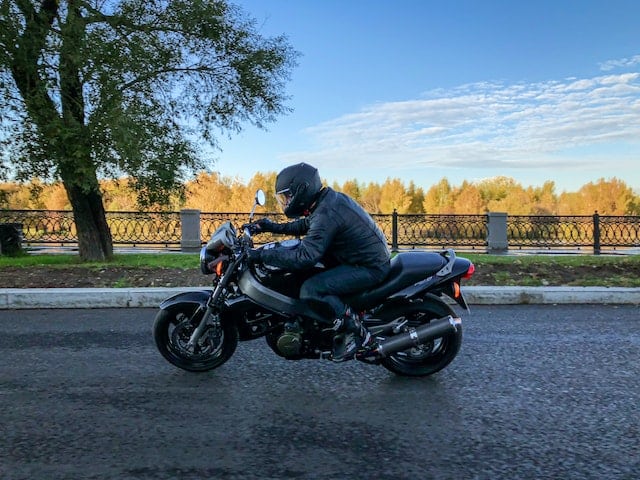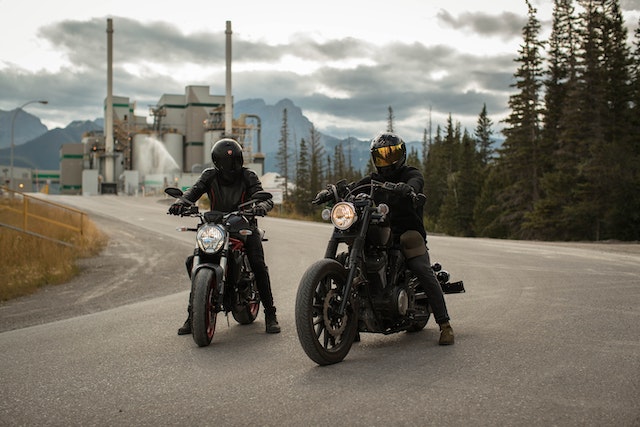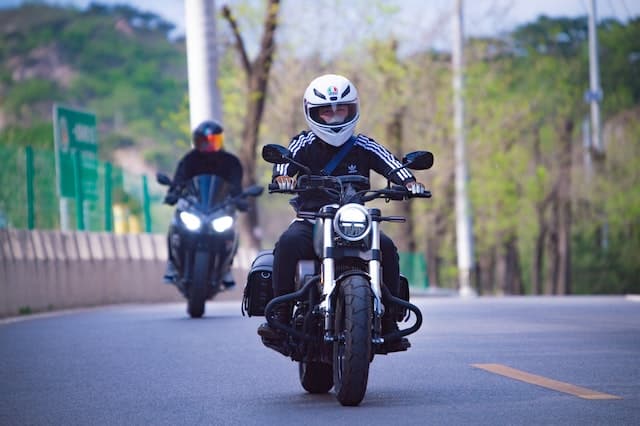Riding Motorcycle in Rain: What You Need To Know

Riding a motorcycle in the rain can be difficult. A rainy day poses different hazards like slippery surfaces and reduced visibility. These conditions can be challenging to navigate for even the most experienced rider.
That said, riding a motorcycle on a rainy day isn’t impossible. If you wear the right gear and follow the correct safety tips, you can ride safely in the rain.
I’ve been riding bikes since I was 16, and have plenty of experience riding in wet weather. In this article, I’ll explain all you need to know about riding a motorcycle in rain and how to do it safely.
Table of Contents
Can You Ride a Motorcycle in the Rain?
Yes, you can ride a motorcycle in the rain, but it requires extra caution and skill. Riding a motorcycle in wet conditions can be more challenging because the road surface can be slippery, and visibility may be reduced. However, with the right equipment, techniques, and mindset, you can safely ride your motorcycle in the rain.

If you want to ride safely in the rain, it’s important to follow certain safety precautions. In the following paragraphs, I’ll be explaining some of the safety tips and how to prepare your motorcycle to ride in the rain.
Important Safety Tips to Keep in Mind When Riding a Motorcycle in the Rain
To minimize the risks associated with riding in the rain, you must follow a few safety precautions.
But before getting to that, let’s take a look at some of the dangers of riding a motorcycle in the rain :
Reduced visibility:
Reduced visibility is one of the most significant dangers of riding a motorcycle in the rain. Rain can obscure your vision, making it difficult to see other vehicles, pedestrians, and road hazards.
Also, rain can create glare and reflections on your helmet visor, further impairing your ability to see. Fogging of the visor can also be a significant problem, and riders must take extra precautions to prevent this from happening.
Reduced traction:
Another significant danger of riding in the rain is reduced traction. Wet roads can be slick, and your motorcycle’s tires may not grip the road as well as they do on dry pavement.
This can make it more challenging to accelerate, brake, and manoeuvre, increasing the risk of skidding or losing control of your bike.
Hydroplaning:
Hydroplaning occurs when a vehicle’s tires lose contact with the road surface due to standing water. This can happen to motorcycles and cars, which can be a terrifying experience for the rider.

When hydroplaning occurs, the bike can slide out from under you, causing you to lose control and potentially crash.
Increased stopping distance:
Wet roads need longer stopping distances than dry roads. When you brake on a wet road, your tires have less grip, and it takes longer for your bike to come to a stop.
This means you need to give yourself more space to stop safely, and you may need to brake earlier and more gently than you would on dry pavement.
Reduced bike performance:
Rain can also affect your motorcycle’s performance. Wet conditions can make it harder for your engine to operate at peak efficiency, and your brakes and suspension may not work as well as they do on dry pavement.
This can affect your bike’s handling and make it more challenging to control.
Other drivers:
In addition to the hazards of wet roads, you must contend with other drivers who may not be paying attention or driving too fast for the conditions.
This can make it more challenging to stay safe on the road and increase the risk of accidents.
Standing water:
Finally, standing water on the road can be a significant hazard for motorcyclists. Puddles can hide deep potholes or other road hazards, and they can also cause hydroplaning.
Riders must be especially cautious when approaching standing water and try to avoid it whenever possible.
Now that you know the dangers that lurk on a rainy day, here are 8 safety tips to help you avoid them:
Wear proper rain gear

Before you ride in the rain, ensure you wear appropriate gear, because a waterproof jacket and pants can help keep you dry and comfortable.
Wet clothing can make you feel colder and cause distractions while you ride, so proper gear can make a big difference in your safety and comfort.
Ensure your boots are waterproof and have a good grip to prevent slipping. Also, consider wearing gloves with insulation and good grip to keep your hands dry and warm.
You can wear a full-face helmet with a clear visor to ensure proper visibility.
Check your tires
The condition of your motorcycle’s tires is crucial for safety when riding in the rain. Worn or underinflated tires can reduce traction and increase the risk of slipping.
You should use tires designed for wet conditions, which have better traction on wet roads.
Slow down and increase your following distance

When it’s raining, remember to slow down and allow yourself time to react to changing road conditions. Wet roads can reduce your traction and increase your stopping distance.
Maintain a safe distance from the vehicle in front of you to avoid skidding or hydroplaning.
Use both brakes
You may be accustomed to using only the front or rear brake in normal conditions. However, you should use both brakes to slow down and stop safely in the rain.
Start with the rear brake, then add the front brake smoothly and gently. Be careful not to lock up the wheels, which can cause skidding.
Avoid sudden movements
Quick turns, sudden stops, and abrupt accelerations can be dangerous in the rain. Smooth, gentle movements can help you avoid skidding and exercise control over your bike.
Be especially cautious when approaching corners or curves, and refrain from suddenly changing direction.
Stay visible
In rainy conditions, visibility can be reduced for both you and other drivers on the road. To stay safe, ensure you’re visible to others using your headlights, taillights, and turn signals.
You may also want to consider wearing reflective clothing or adding reflective tape to your motorcycle to increase your visibility.
Watch out for standing water
Puddles and standing water on the road can be especially hazardous for motorcycles. Even shallow water can reduce traction and cause hydroplaning.
Try to avoid riding through standing water, and if you can’t avoid it, slow down and stay as upright as possible to reduce the risk of skidding.
Be prepared for emergencies
Finally, it’s important to be prepared for emergencies when riding in the rain.
Carry a first aid kit and a tool kit with you, and make sure your phone’s battery is fully charged in case you need to call someone for help. If possible, ride with a companion who can assist you in case of an emergency.
How Do You Prepare Your Motorcycle to Ride in the Rain?
With proper preparation, riding in the rain can be a safe and enjoyable experience. In this section, I’ll explain the steps to follow to prepare your motorcycle to ride in the rain:

Step 1: Install Tires With Good Traction:
The first step to prepare for riding a motorcycle in the rain is to choose tires that provide good traction and grip on wet roads. Here are a few types of tires that are appropriate for riding a motorcycle in the rain:
-
- Rain tires: These tires are specifically designed for wet weather riding, with a tread pattern that helps to disperse water and provide a better grip on wet roads.
-
- All-weather tires: These are designed to perform well in wet and dry conditions, with a tread pattern that provides a good grip in the rain.
-
- Touring tires: These tires are designed for long-distance riding and offer good wet weather performance, with a tread pattern that provides good traction on wet roads.
-
- Sport-touring tires: These tires are designed for sporty riding but also offer good wet-weather performance, with a tread pattern that provides a good grip in the rain.
Step 2: Check Your Tires
One of the most crucial steps is to check your tires. They must have proper tread depth and be properly inflated.
It would be best to replace your tires before riding in the rain, especially if they are worn out. The tread on your tires helps to disperse water and provides grip on wet surfaces.
If your tires are under-inflated, they will reduce the contact patch with the road, leading to less grip and potentially causing a dangerous situation.
Step 3: Check Your Brakes
Ensure that your brake pads are in good condition and have enough life left in them. Brake pads can wear down more quickly in wet conditions, so checking them before heading out is essential.

Also, ensure that your brake discs are clean and rust-free. Rusty discs can reduce the effectiveness of your brakes, especially in wet conditions.
Step 4: Check Your Lights
Check that all your lights are working correctly, including your headlights, taillights, and turn signals. In wet conditions, visibility is reduced, and having functioning lights is essential to ensure you are visible to other drivers on the road.
Step 5: Check Your Chain
If your motorcycle has a chain drive, ensure it is clean and lubricated. In wet conditions, the chain can pick up dirt and debris, which can cause it to wear out more quickly.
Clean and lubricate the chain regularly to keep it in good condition.
Step 6: Check your windshield or fairing
If your motorcycle has a windshield or fairing, ensure it’s clean and free of scratches. Scratches can create glare in the rain, making it harder to see.
Step 7: Park Your Bike Safely
After your ride, park your bike safely in a dry place. Avoid parking on wet surfaces, as this can cause your bike to slide or tip over. If possible, park your bike in a garage or under a covered area.
FAQ
Will my motorcycle be OK in the rain?
Motorcycles can be ridden in the rain without any major problems if you take some precautions and ensure your motorcycle is in good condition. But if you encounter severe weather conditions such as heavy rain, lightning, or flooding, it’s always best to avoid riding and wait for conditions to improve.
What is the most slippery part of a wet road?
The most slippery part of a wet road is typically the areas with standing water or puddles. These areas can cause a thin layer of water to form between your vehicle’s tires and the road surface, reducing the tire’s ability to grip the road and increasing the likelihood of hydroplaning.
What weather should you not ride a motorcycle?
Riding a motorcycle in adverse weather conditions such as heavy rain, snow, sleet, hail, or strong winds can be dangerous and should be avoided. In addition, extremely hot or cold temperatures can affect a rider’s comfort and ability to safely handle the motorcycle. Hence, it is important to dress appropriately for the weather. Ultimately, it is up to the rider to assess the weather conditions and determine whether it is safe to ride or not.
Final Thoughts
Riding a motorcycle in the rain can be a challenging and potentially dangerous experience. But with proper preparation and precautions, it can be done safely. Before heading out, it is crucial to ensure your motorcycle is in good condition, with properly inflated tires and functioning brakes and lights.
Additionally, wearing the appropriate gear, such as waterproof clothing, gloves, and boots, can help keep you dry and improve visibility. It is also essential to adjust your riding style to account for the reduced traction and visibility that comes with riding in the rain. If you follow the safety precautions outlined above and use the correct gear, you shouldn’t have too much trouble riding a motorcycle in the rain.
